Vai trò của tương tác xã hội, sự gắn bó với thương hiệu và sự hài lòng trong việc ảnh hưởng lên ý định tiếp tục sử dụng và truyền miệng đối với ứng dụng di động mang thương hiệu: Một nghiên cứu thực nghiệm trong bối cảnh Việt Nam
Các ứng dụng thương hiệu trên điện thoại di động đang ngày càng được xây dựng bởi
nhiều công ty khác nhau, những người mong muốn thay đổi cách thức người tiêu dùng giao tiếp
với thương hiệu, khuyến khích họ kết nối và tương tác với thương hiệu cũng như kiểm soát tương
tác giữa người tiêu dùng và thương hiệu một cách hiệu quả hơn. Nghiên cứu này nhằm mục
đích điều tra vai trò của tương tác xã hội, sự gắn bó với thương hiệu và sự hài lòng của người
tiêu dùng trong việc dự đoán ý định tiếp tục sử dụng và ý định truyền miệng đối với các ứng
dụng mang thương hiệu trên thiết bị di động. Mô hình nghiên cứu được khảo sát thực nghiệm
với 250 câu trả lời được thực hiện từ những người trẻ Việt Nam. Kết quả nghiên cứu đã xác
định tác động của tương tác xã hội, sự gắn bó với thương hiệu và sự hài lòng đối với ý định tiếp
tục sử dụng và ý định truyền miệng đối với các ứng dụng mang thương hiệu trên thiết bị di động.
Kết quả nghiên cứu cũng cho thấy những ảnh hưởng tích cực của trải nghiệm đối với ứng dụng
mang thương hiệu và tính hữu ích cảm nhận lên tương tác xã hội, sự gắn bó với thương hiệu và
sự hài lòng.
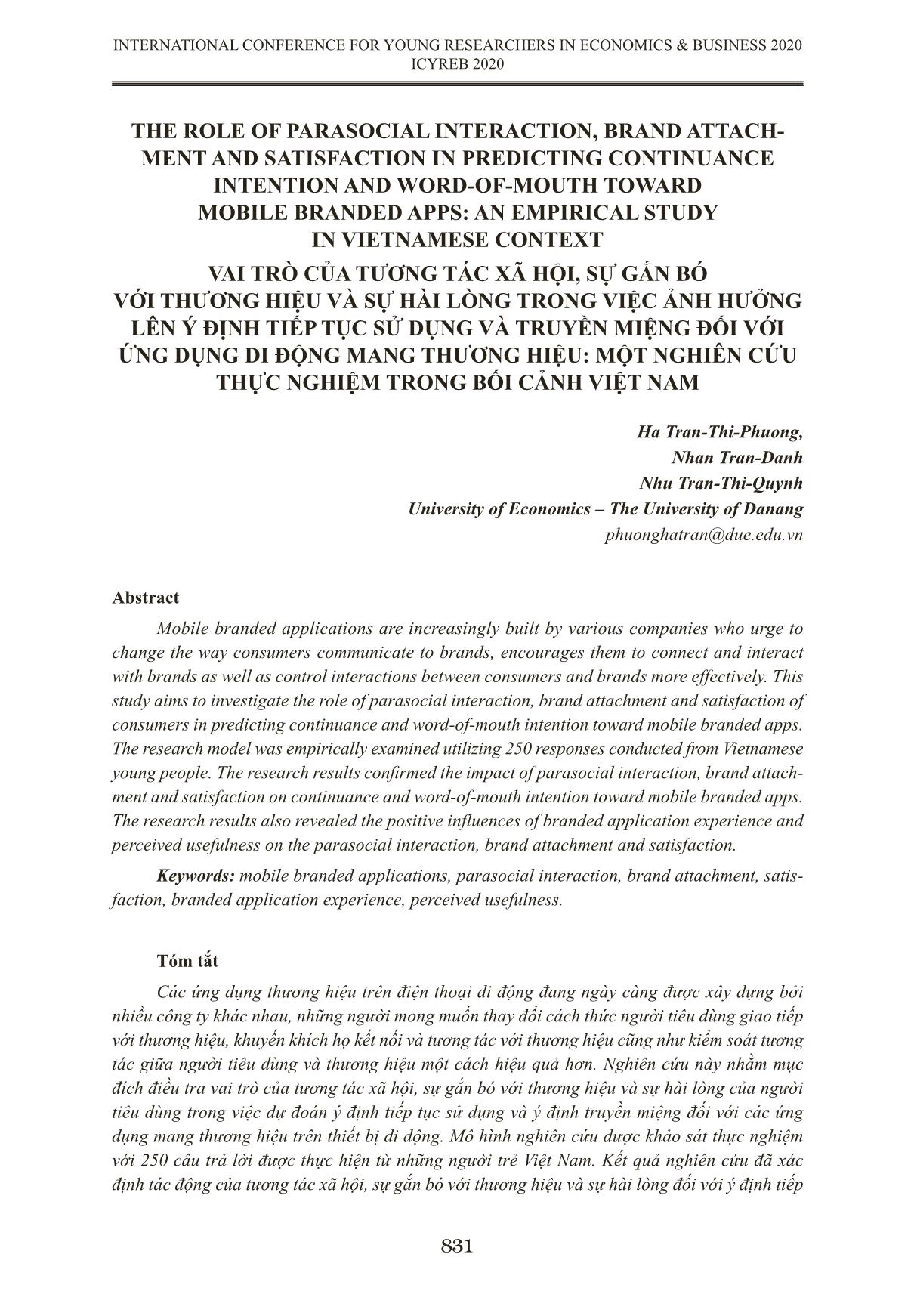
Trang 1
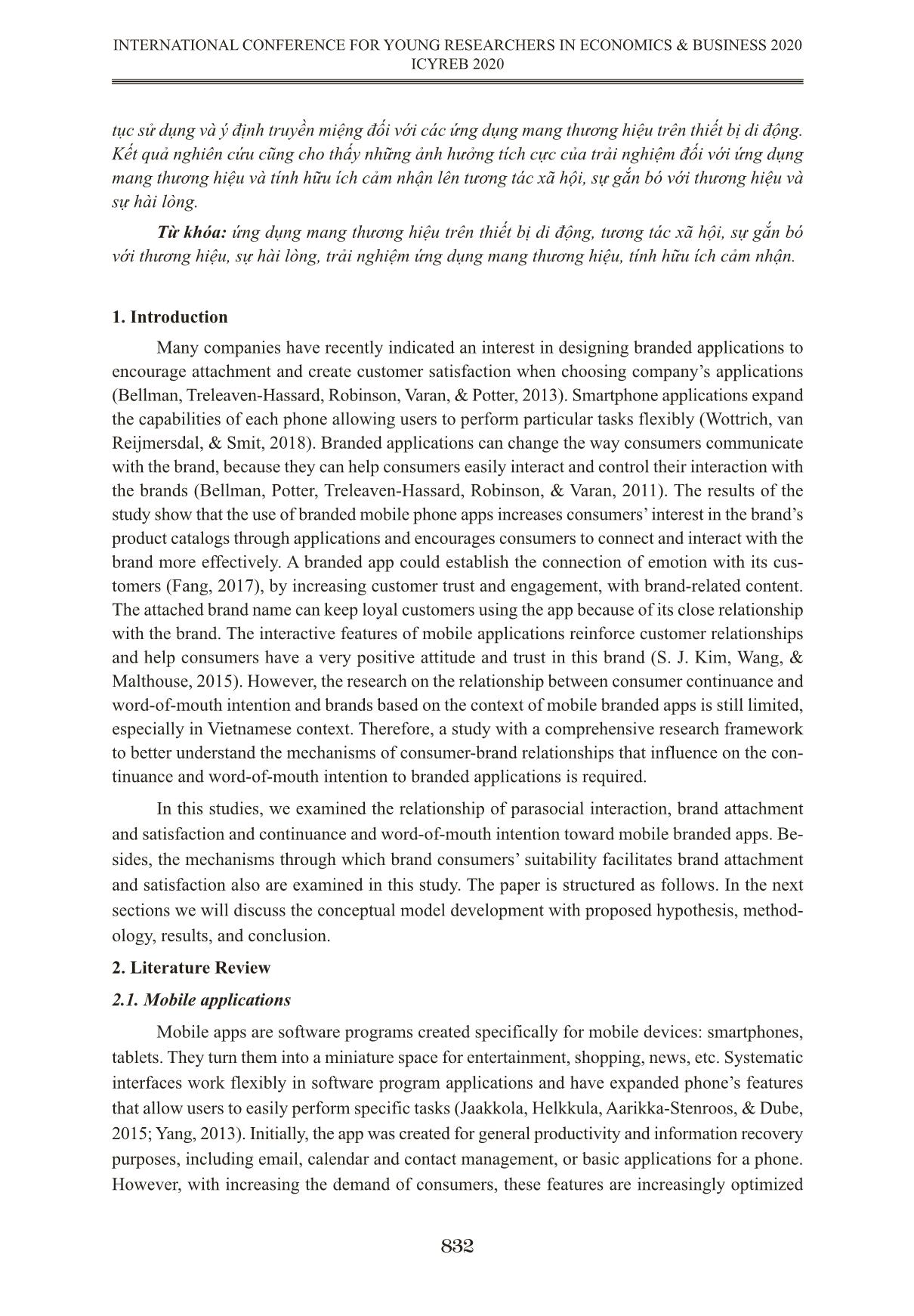
Trang 2
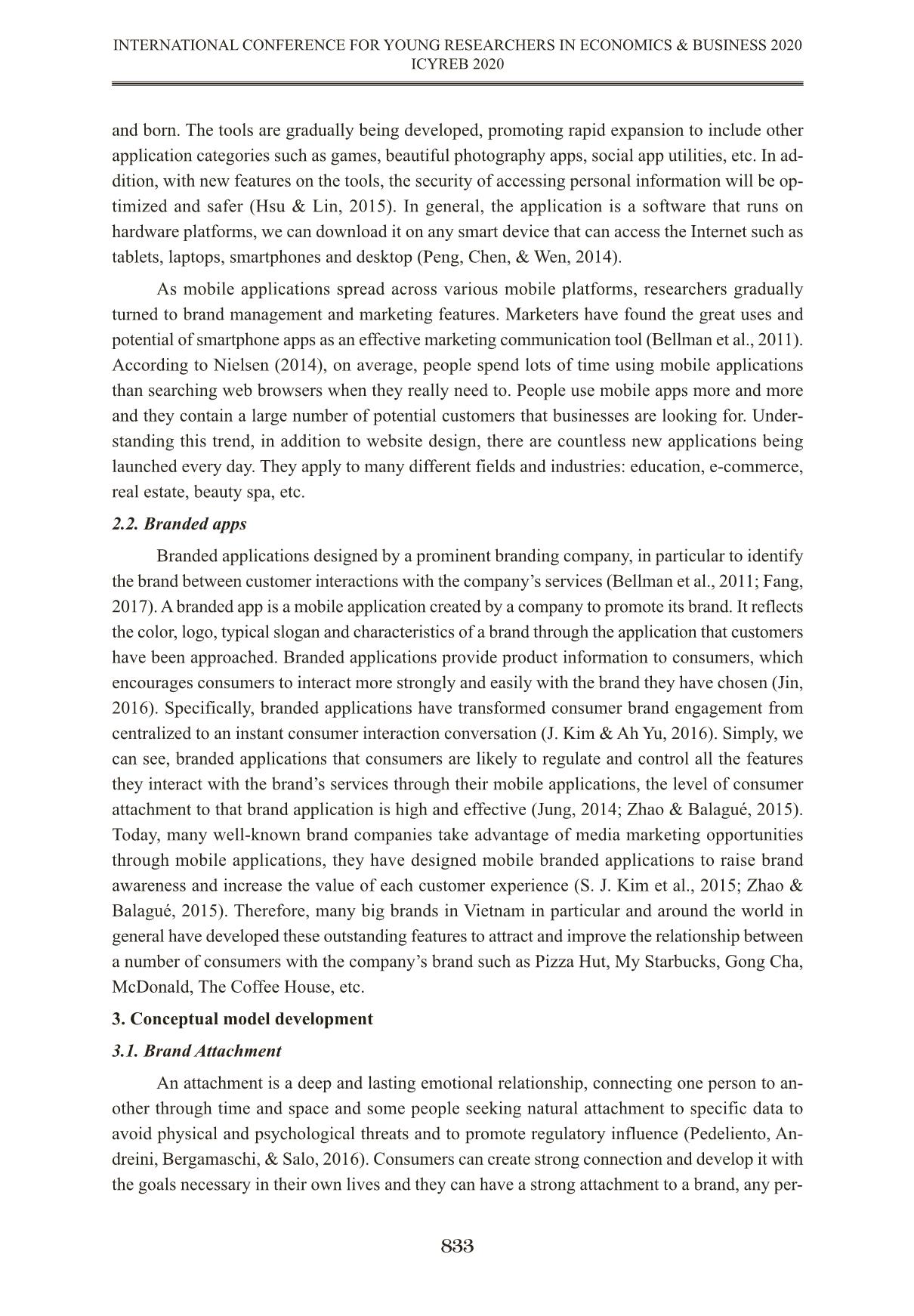
Trang 3
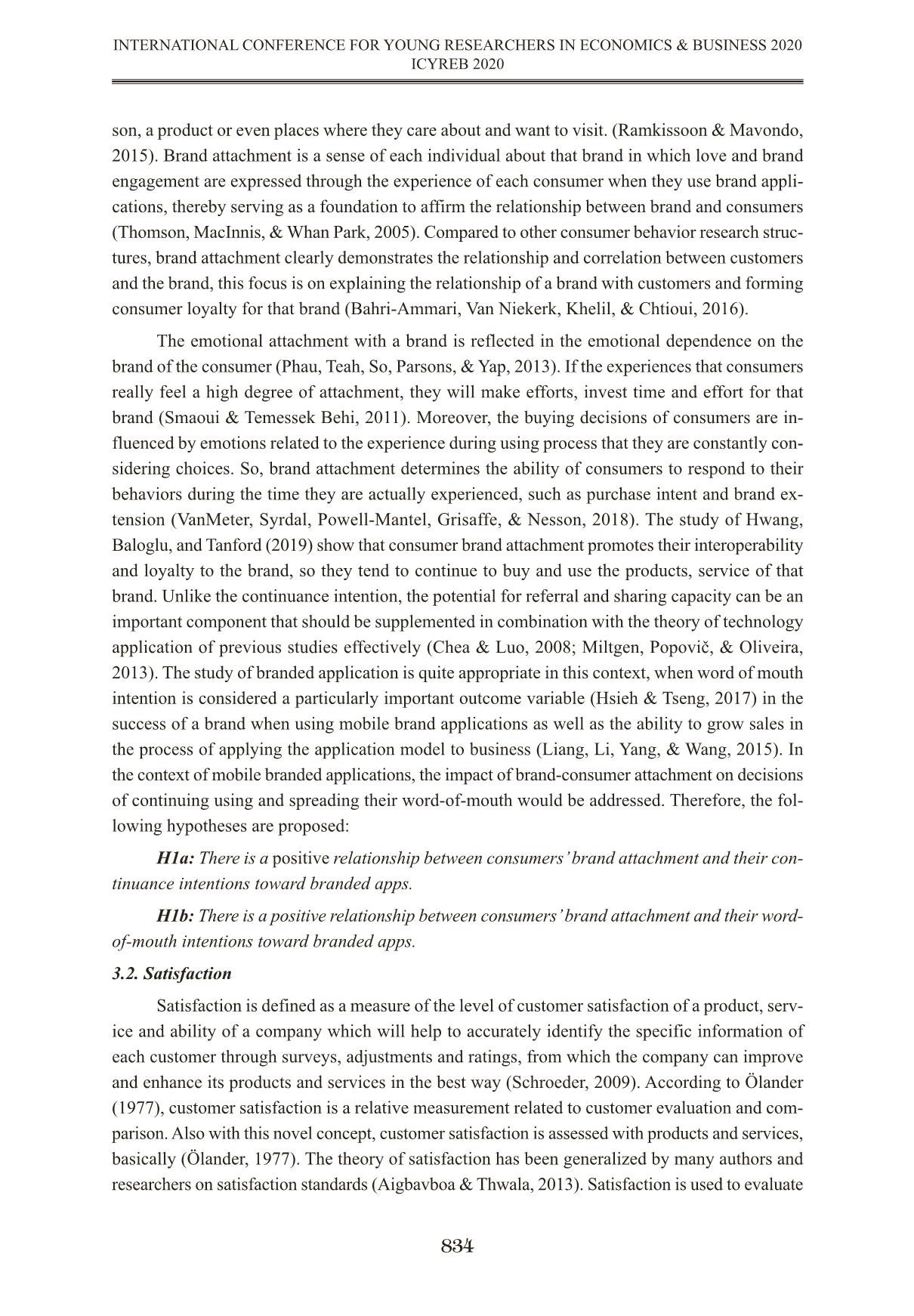
Trang 4
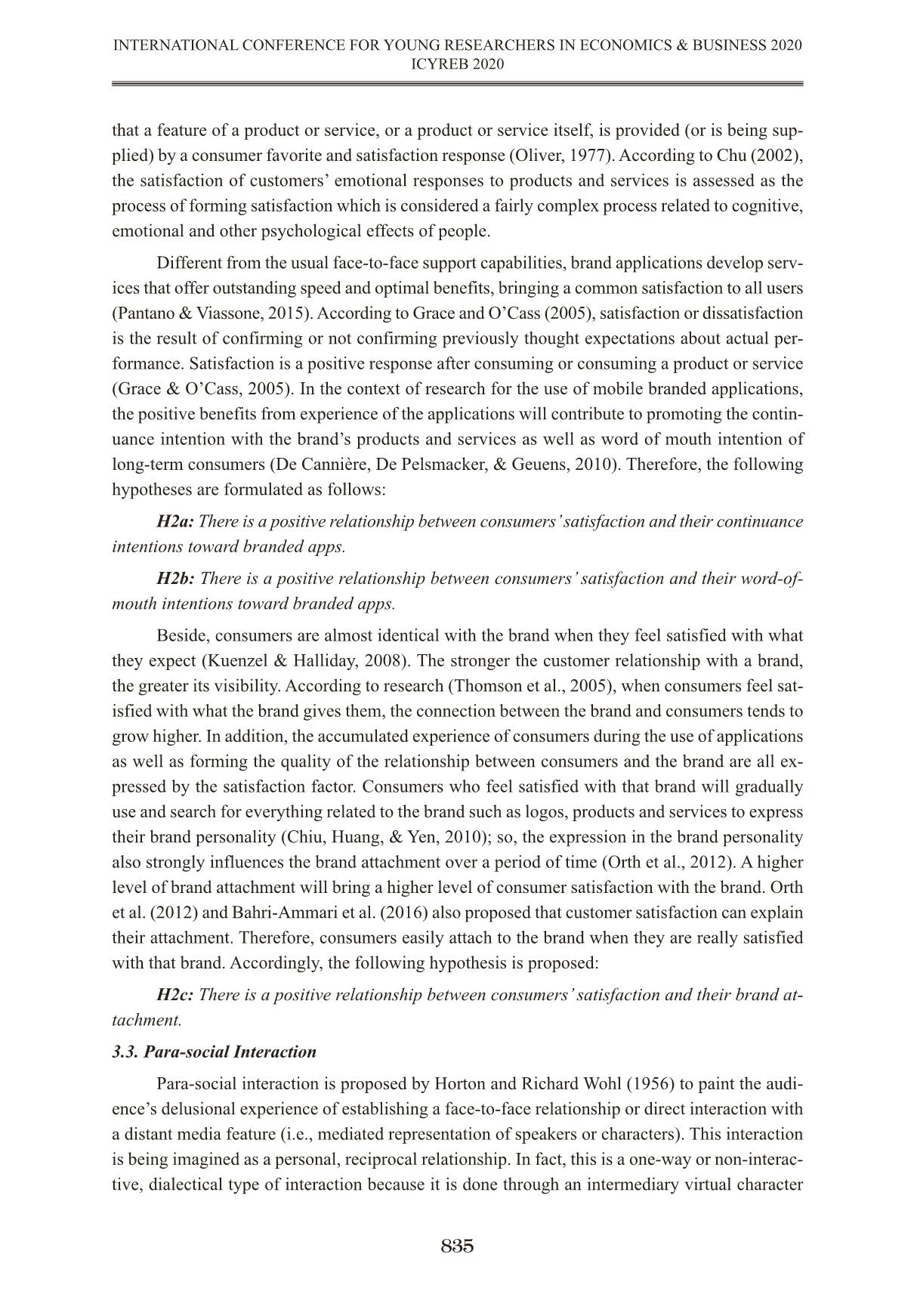
Trang 5
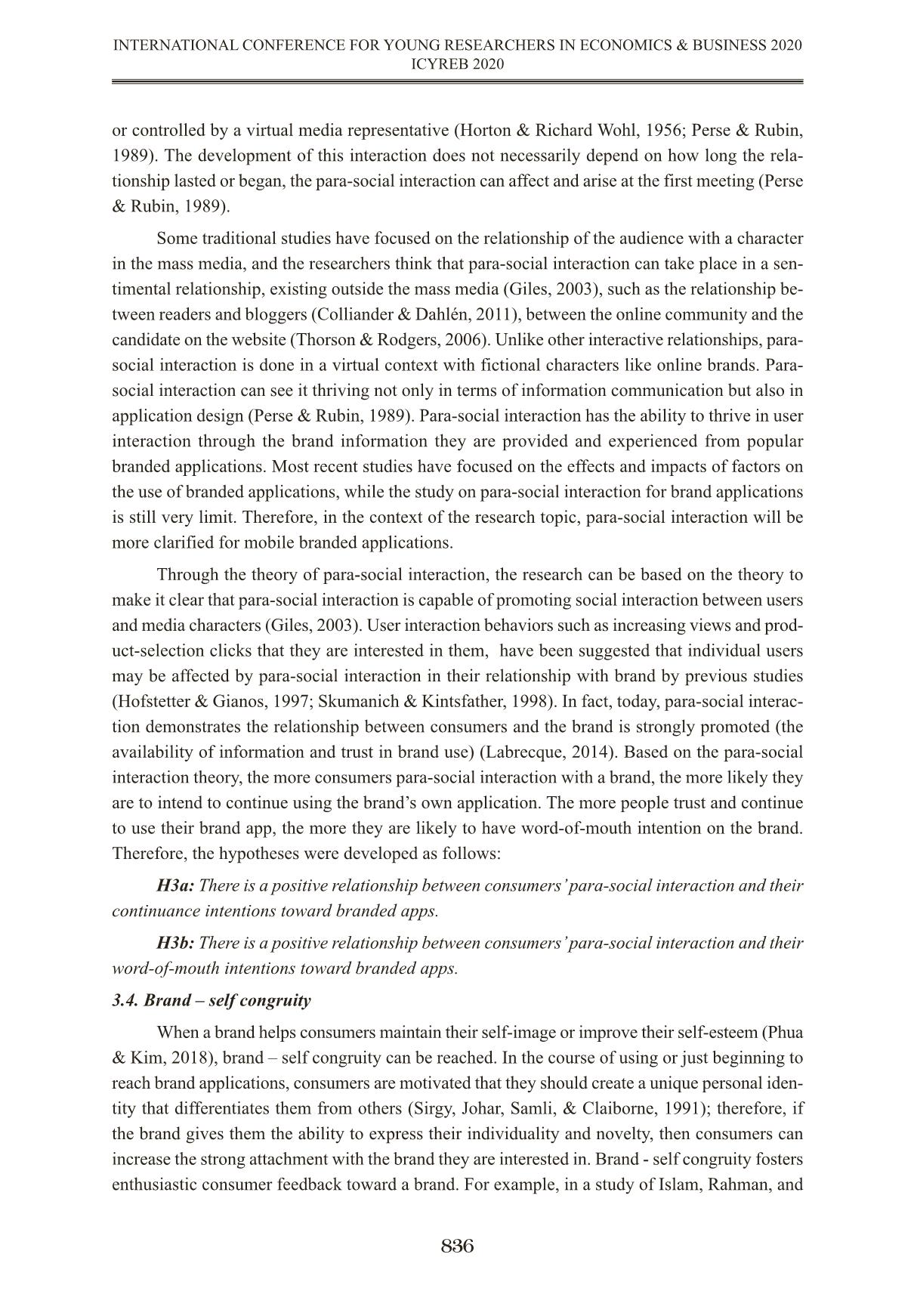
Trang 6
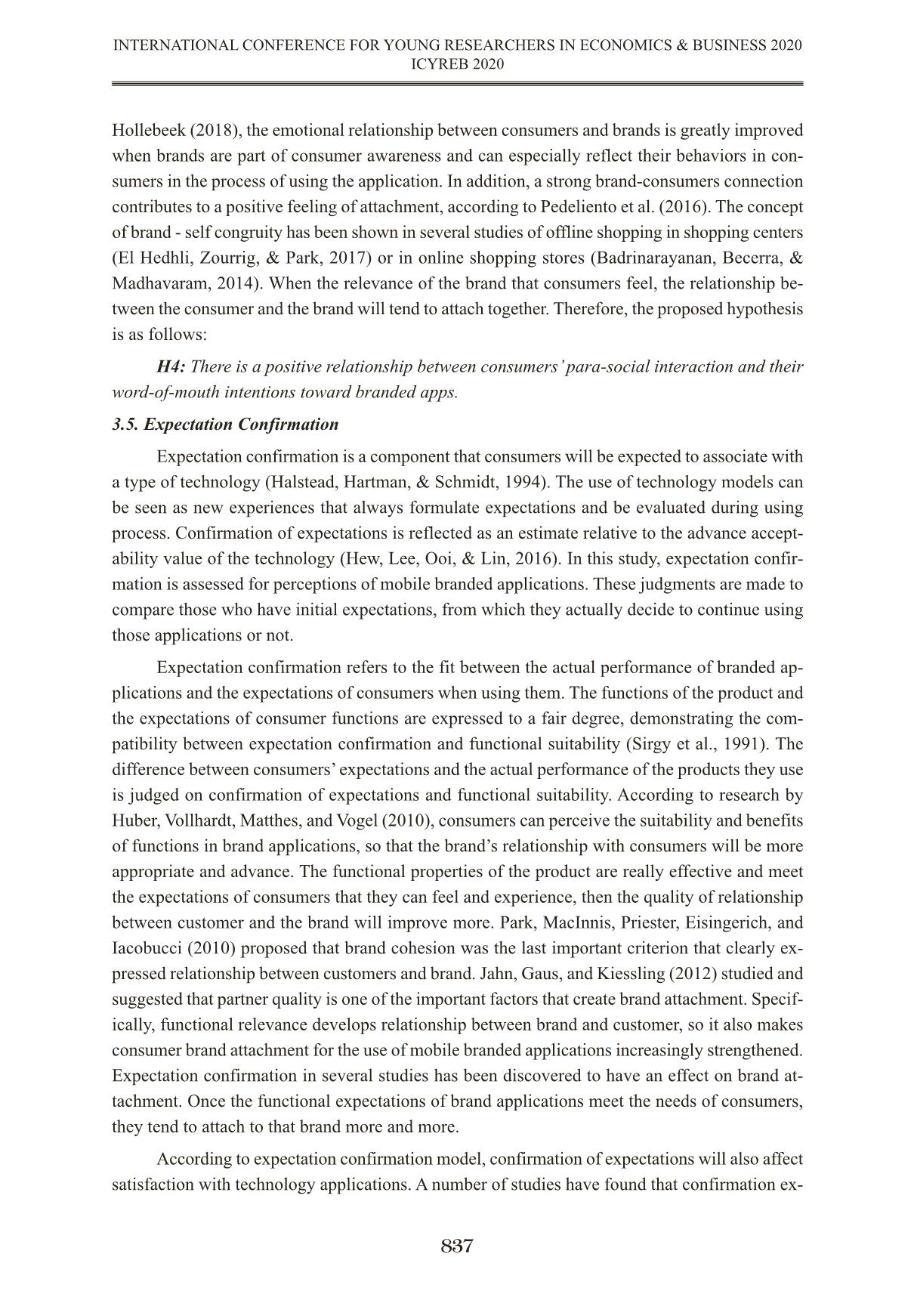
Trang 7
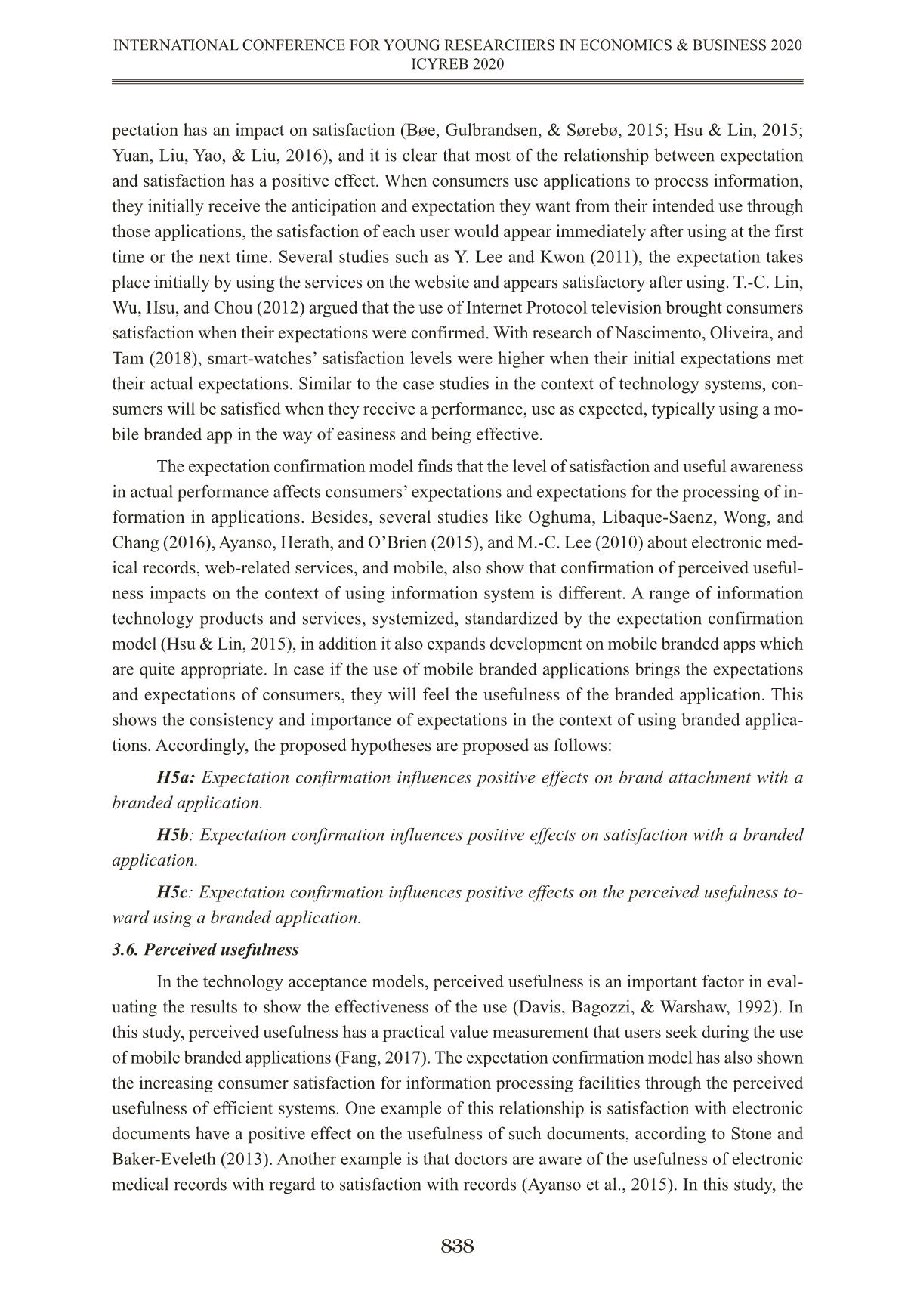
Trang 8
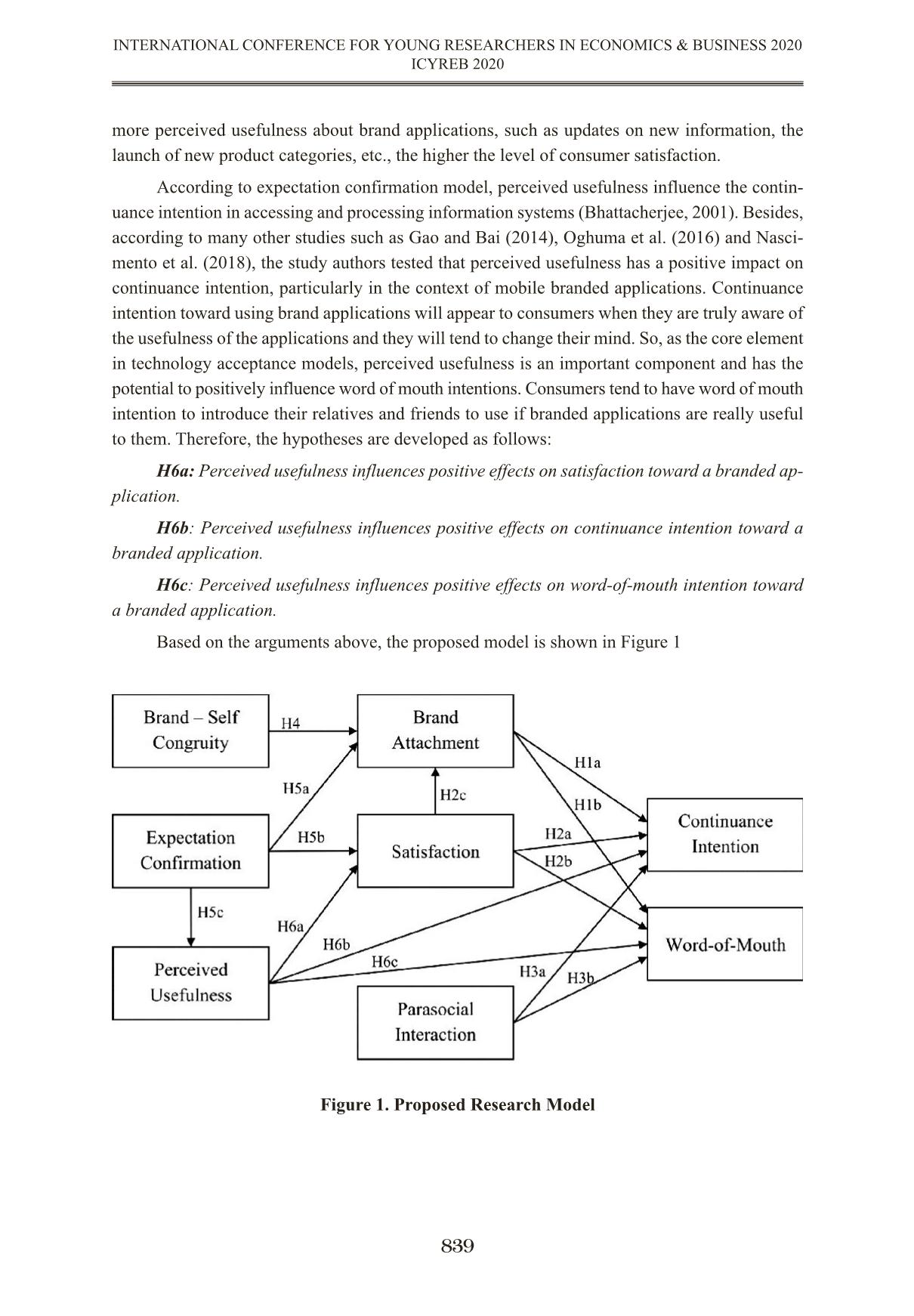
Trang 9
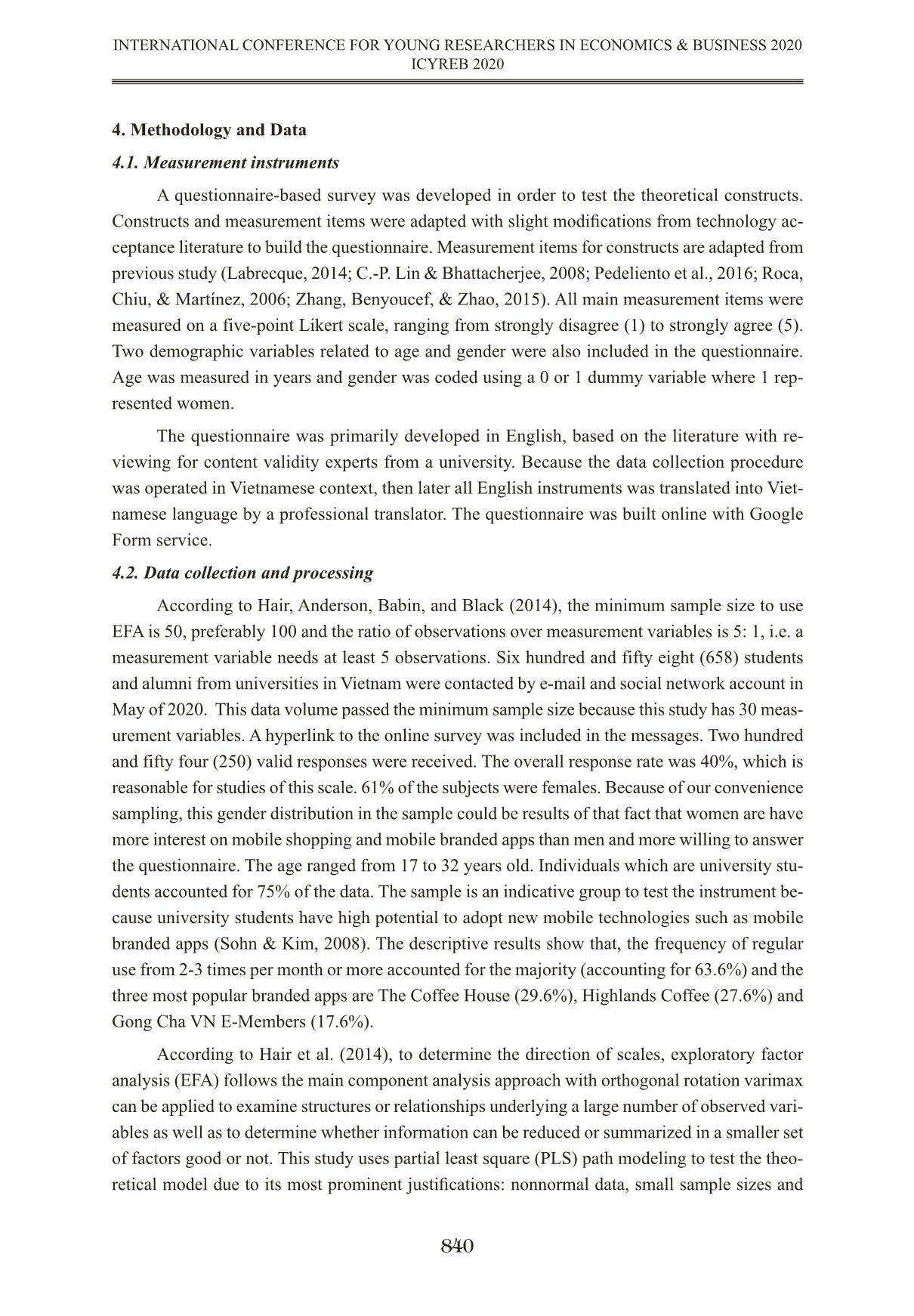
Trang 10
Tải về để xem bản đầy đủ
Tóm tắt nội dung tài liệu: Vai trò của tương tác xã hội, sự gắn bó với thương hiệu và sự hài lòng trong việc ảnh hưởng lên ý định tiếp tục sử dụng và truyền miệng đối với ứng dụng di động mang thương hiệu: Một nghiên cứu thực nghiệm trong bối cảnh Việt Nam
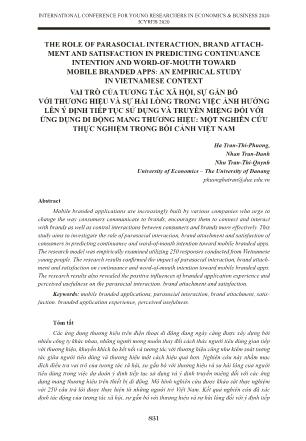
THE ROLE OF PARASOCIAL INTERACTION, BRAND ATTACH- MENT AND SATISFACTION IN PREDICTING CONTINUANCE INTENTION AND WORD-OF-MOUTH TOWARD MOBILE BRANDED APPS: AN EMPIRICAL STUDY IN VIETNAMESE CONTEXT VAI TRÒ CỦA TƯƠNG TÁC XÃ HỘI, SỰ GẮN BÓ VỚI THƯƠNG HIỆU VÀ SỰ HÀI LÒNG TRONG VIỆC ẢNH HƯỞNG LÊN Ý ĐỊNH TIẾP TỤC SỬ DỤNG VÀ TRUYỀN MIỆNG ĐỐI VỚI ỨNG DỤNG DI ĐỘNG MANG THƯƠNG HIỆU: MỘT NGHIÊN CỨU THỰC NGHIỆM TRONG BỐI CẢNH VIỆT NAM Ha Tran-Thi-Phuong, Nhan Tran-Danh Nhu Tran-Thi-Quynh University of Economics – The University of Danang phuonghatran@due.edu.vn Abstract Mobile branded applications are increasingly built by various companies who urge to change the way consumers communicate to brands, encourages them to connect and interact with brands as well as control interactions between consumers and brands more effectively. This study aims to investigate the role of parasocial interaction, brand attachment and satisfaction of consumers in predicting continuance and word-of-mouth intention toward mobile branded apps. The research model was empirically examined utilizing 250 responses conducted from Vietnamese young people. The research results confirmed the impact of parasocial interaction, brand attach- ment and satisfaction on continuance and word-of-mouth intention toward mobile branded apps. The research results also revealed the positive influences of branded application experience and perceived usefulness on the parasocial interaction, brand attachment and satisfaction. Keywords: mobile branded applications, parasocial interaction, brand attachment, satis- faction, branded application experience, perceived usefulness. Tóm tắt Các ứng dụng thương hiệu trên điện thoại di động đang ngày càng được xây dựng bởi nhiều công ty khác nhau, những người mong muốn thay đổi cách thức người tiêu dùng giao tiếp với thương hiệu, khuyến khích họ kết nối và tương tác với thương hiệu cũng như kiểm soát tương tác giữa người tiêu dùng và thương hiệu một cách hiệu quả hơn. Nghiên cứu này nhằm mục đích điều tra vai trò của tương tác xã hội, sự gắn bó với thương hiệu và sự hài lòng của người tiêu dùng trong việc dự đoán ý định tiếp tục sử dụng và ý định truyền miệng đối với các ứng dụng mang thương hiệu trên thiết bị di động. Mô hình nghiên cứu được khảo sát thực nghiệm với 250 câu trả lời được thực hiện từ những người trẻ Việt Nam. Kết quả nghiên cứu đã xác định tác động của tương tác xã hội, sự gắn bó với thương hiệu và sự hài lòng đối với ý định tiếp 831 INTERNATIONAL CONFERENCE FOR YOUNG RESEARCHERS IN ECONOMICS & BUSINESS 2020 ICYREB 2020 tục sử dụng và ý định truyền miệng đối với các ứng dụng mang thương hiệu trên thiết bị di động. Kết quả nghiên cứu cũng cho thấy những ảnh hưởng tích cực của trải nghiệm đối với ứng dụng mang thương hiệu và tính hữu ích cảm nhận lên tương tác xã hội, sự gắn bó với thương hiệu và sự hài lòng. Từ khóa: ứng dụng mang thương hiệu trên thiết bị di động, tương tác xã hội, sự gắn bó với thương hiệu, sự hài lòng, trải nghiệm ứng dụng mang thương hiệu, tính hữu ích cảm nhận. 1. Introduction Many companies have recently indicated an interest in designing branded applications to encourage attachment and create customer satisfaction when choosing company’s applications (Bellman, Treleaven-Hassard, Robinson, Varan, & Potter, 2013). Smartphone applications expand the capabilities of each phone allowing users to perform particular tasks flexibly (Wottrich, van Reijmersdal, & Smit, 2018). Branded applications can change the way consumers communicate with the brand, because they can help consumers easily interact and control their interaction with the brands (Bellman, Potter, Treleaven-Hassard, Robinson, & Varan, 2011). The results of the study show that the use of branded mobile phone apps increases consumers’ interest in the brand’s product catalogs through applications and encourages consumers to connect and interact with the brand more effectively. A branded app could establish the connection of emotion with its cus- tomers (Fang, 2017), by increasing customer trust and engagement, with brand-related content. The attached brand name can keep loyal customers using the app because of its close relationship with the brand. The interactive features of mobile applications reinforce customer relationships and help consumers have a very positive attitude and trust in this brand (S. J. Kim, Wang, & Malthouse, 2015). However, the research on the relationship between consumer continuance and word-of-mouth intention and brands based on the context of mobile branded apps is still limited, especially in Vietnamese context. Therefore, a study with a comprehensive research framework to better understand the mechanisms of consumer-brand relationships that influence on the con- tinuance and word-of-mouth intention to branded applications is required. In this studies, we examined the relationship of parasocial interaction, brand attachment and satisfactio ... s. It is likely that seniors and less educated consumers or those who hold low computing or Internet-related capa- bility would recognize more difficulty in adopting mobile branded apps. Future research can be constructed based on this study by examining the proposed model in different age groups or ap- plying this model to other countries and also other contexts. 847 INTERNATIONAL CONFERENCE FOR YOUNG RESEARCHERS IN ECONOMICS & BUSINESS 2020 ICYREB 2020 REFERENCES Aigbavboa, C., & Thwala, W. (2013). Housing satisfaction in subsidized housing schemes: A case study of Johannesburg, Gauteng Province, South Africa. Journal of Human Ecology, 42(3), 245-257. Ayanso, A., Herath, T. C., & O’Brien, N. (2015). Understanding continuance intentions of physicians with electronic medical records (EMR): An expectancy-confirmation perspective. De- cision support systems, 77, 112-122. Badrinarayanan, V., Becerra, E. P., & Madhavaram, S. (2014). Influence of congruity in store-attribute dimensions and self-image on purchase intentions in online stores of multichannel retailers. Journal of Retailing and Consumer Services, 21(6), 1013-1020. Bahri-Ammari, N., Van Niekerk, M., Khelil, H. B., & Chtioui, J. (2016). The effects of brand attachment on behavioral loyalty in the luxury restaurant sector. International Journal of Contemporary Hospitality Management. Bellman, S., Potter, R. F., Treleaven-Hassard, S., Robinson, J. A., & Varan, D. (2011). The effectiveness of branded mobile phone apps. Journal of interactive Marketing, 25(4), 191-200. Bellman, S., Treleaven-Hassard, S., Robinson, J. A., Varan, D., & Potter, R. F. (2013). Brand communication with branded smartphone apps: First insights on possibilities and limits. GfK Marketing Intelligence Review, 5(2), 24-27. Bhattacherjee, A. (2001). Understanding information systems continuance: an expectation- confirmation model. MIS quarterly, 351-370. Bøe, T., Gulbrandsen, B., & Sørebø, Ø. (2015). How to stimulate the continued use of ICT in higher education: Integrating information systems continuance theory and agency theory. Com- puters in Human Behavior, 50, 375-384. Chea, S., & Luo, M. M. (2008). Post-adoption behaviors of e-service customers: The in- terplay of cognition and emotion. International Journal of Electronic Commerce, 12(3), 29-56. Chiu, C.-M., Huang, H.-Y., & Yen, C.-H. (2010). Antecedents of trust in online auctions. Electronic Commerce Research and Applications, 9(2), 148-159. Chu, R. (2002). Stated‐importance versus derived‐importance customer satisfaction meas- urement. Journal of Services Marketing. Colliander, J., & Dahlén, M. (2011). Following the fashionable friend: The power of social media: Weighing publicity effectiveness of blogs versus online magazines. Journal of advertising research, 51(1), 313-320. Davis, F. D., Bagozzi, R. P., & Warshaw, P. R. (1992). Extrinsic and intrinsic motivation to use computers in the workplace 1. Journal of applied social psychology, 22(14), 1111-1132. De Cannière, M. H., De Pelsmacker, P., & Geuens, M. (2010). Relationship quality and purchase intention and behavior: The moderating impact of relationship strength. Journal of Busi- ness and Psychology, 25(1), 87-98. El Hedhli, K., Zourrig, H., & Park, J. (2017). Image transfer from malls to stores and its 848 INTERNATIONAL CONFERENCE FOR YOUNG RESEARCHERS IN ECONOMICS & BUSINESS 2020 ICYREB 2020 influence on shopping values and mall patronage: The role of self-congruity. Journal of Retailing and Consumer Services, 39, 208-218. Fang, Y. H. (2017). Beyond the usefulness of branded applications: Insights from con- sumer–brand engagement and self‐construal perspectives. Psychology & Marketing, 34(1), 40-58. Gao, L., & Bai, X. (2014). An empirical study on continuance intention of mobile social networking services. Asia Pacific Journal of Marketing and Logistics. Giles, D. (2003). Media psychology: Routledge. Grace, D., & O’Cass, A. (2005). An examination of the antecedents of repatronage inten- tions across different retail store formats. Journal of Retailing and Consumer Services, 12(4), 227-243. Hair, J. F., Anderson, R. E., Babin, B. J., & Black, W. C. (2014). Multivariate data analysis: A global perspective (Vol. 7): Upper Saddle River, NJ: Pearson. Hair Jr, J. F., Hult, G. T. M., Ringle, C., & Sarstedt, M. (2017). A primer on partial least squares structural equation modeling (PLS-SEM): Sage publications. Hair Jr, J. F., Sarstedt, M., Hopkins, L., & Kuppelwieser, V. G. (2014). Partial least squares structural equation modeling (PLS-SEM). European business review. Halstead, D., Hartman, D., & Schmidt, S. L. (1994). Multisource effects on the satisfaction formation process. Journal of the Academy of marketing science, 22(2), 114-129. Henseler, J., Ringle, C. M., & Sinkovics, R. R. (2009). The use of partial least squares path modeling in international marketing New challenges to international marketing: Emerald Group Publishing Limited. Hew, J.-J., Lee, V.-H., Ooi, K.-B., & Lin, B. (2016). Mobile social commerce: The booster for brand loyalty? Computers in Human Behavior, 59, 142-154. Hofstetter, C. R., & Gianos, C. L. (1997). Political talk radio: Actions speak louder than words. Journal of Broadcasting & Electronic Media, 41(4), 501-515. Horton, D., & Richard Wohl, R. (1956). Mass communication and para-social interaction: Observations on intimacy at a distance. Psychiatry, 19(3), 215-229. Hsieh, S. H., & Tseng, T. H. (2017). Playfulness in mobile instant messaging: Examining the influence of emoticons and text messaging on social interaction. Computers in Human Be- havior, 69, 405-414. Hsu, C.-L., & Lin, J. C.-C. (2015). What drives purchase intention for paid mobile apps?– An expectation confirmation model with perceived value. Electronic Commerce Research and Applications, 14(1), 46-57. Huber, F., Vollhardt, K., Matthes, I., & Vogel, J. (2010). Brand misconduct: Consequences on consumer–brand relationships. Journal of Business Research, 63(11), 1113-1120. Hwang, E., Baloglu, S., & Tanford, S. (2019). Building loyalty through reward programs: 849 INTERNATIONAL CONFERENCE FOR YOUNG RESEARCHERS IN ECONOMICS & BUSINESS 2020 ICYREB 2020 The influence of perceptions of fairness and brand attachment. International Journal of Hospi- tality Management, 76, 19-28. Islam, J. U., Rahman, Z., & Hollebeek, L. D. (2018). Consumer engagement in online brand communities: a solicitation of congruity theory. Internet Research. Jaakkola, E., Helkkula, A., Aarikka-Stenroos, L., & Dube, A. (2015). Service experiences beyond the direct use: indirect customer use experiences of smartphone apps. Journal of Service Management. Jahn, S., Gaus, H., & Kiessling, T. (2012). Trust, commitment, and older women: Exploring brand attachment differences in the elderly segment. Psychology & Marketing, 29(6), 445-457. Jin, C.-H. (2016). The effects of mental simulations, innovativeness on intention to adopt brand application. Computers in Human Behavior, 54, 682-690. Jung, Y. (2014). What a smartphone is to me: understanding user values in using smart- phones. Information Systems Journal, 24(4), 299-321. Kim, J., & Ah Yu, E. (2016). The holistic brand experience of branded mobile applications affects brand loyalty. Social Behavior and Personality: an international journal, 44(1), 77-87. Kim, S. J., Wang, R. J.-H., & Malthouse, E. C. (2015). The effects of adopting and using a brand’s mobile application on customers’ subsequent purchase behavior. Journal of interactive Marketing, 31, 28-41. Kuenzel, S., & Halliday, S. V. (2008). Investigating antecedents and consequences of brand identification. Journal of Product & Brand Management. Labrecque, L. I. (2014). Fostering consumer–brand relationships in social media environ- ments: The role of parasocial interaction. Journal of interactive Marketing, 28(2), 134-148. Lee, M.-C. (2010). Explaining and predicting users’ continuance intention toward e-learn- ing: An extension of the expectation–confirmation model. Computers & Education, 54(2), 506- 516. Lee, Y., & Kwon, O. (2011). Intimacy, familiarity and continuance intention: An extended expectation–confirmation model in web-based services. Electronic Commerce Research and Ap- plications, 10(3), 342-357. Liang, T.-P., Li, X., Yang, C.-T., & Wang, M. (2015). What in consumer reviews affects the sales of mobile apps: A multifacet sentiment analysis approach. International Journal of Elec- tronic Commerce, 20(2), 236-260. Lin, C.-P., & Bhattacherjee, A. (2008). Elucidating individual intention to use interactive information technologies: The role of network externalities. International Journal of Electronic Commerce, 13(1), 85-108. Lin, T.-C., Wu, S., Hsu, J. S.-C., & Chou, Y.-C. (2012). The integration of value-based adoption and expectation–confirmation models: An example of IPTV continuance intention. De- cision support systems, 54(1), 63-75. Miltgen, C. L., Popovič, A., & Oliveira, T. (2013). Determinants of end-user acceptance 850 INTERNATIONAL CONFERENCE FOR YOUNG RESEARCHERS IN ECONOMICS & BUSINESS 2020 ICYREB 2020 of biometrics: Integrating the “Big 3” of technology acceptance with privacy context. Decision support systems, 56, 103-114. Nascimento, B., Oliveira, T., & Tam, C. (2018). Wearable technology: What explains con- tinuance intention in smartwatches? Journal of Retailing and Consumer Services, 43, 157-169. Nielsen, F. (2014). How smartphones are changing consumers’ daily routines around the globe. Oghuma, A. P., Libaque-Saenz, C. F., Wong, S. F., & Chang, Y. (2016). An expectation- confirmation model of continuance intention to use mobile instant messaging. Telematics and Informatics, 33(1), 34-47. Ölander, F. (1977). Can consumer dissatisfaction and complaints guide public consumer policy? Zeitschrift für Verbraucherpolitik, 1, 124-137. Oliver, R. L. (1977). Effect of expectation and disconfirmation on postexposure product evaluations: An alternative interpretation. Journal of applied psychology, 62(4), 480. Orth, U. R., Stöckl, A., Veale, R., Brouard, J., Cavicchi, A., Faraoni, M., . . . Rodriguez- Santos, C. (2012). Using attribution theory to explain tourists’ attachments to place-based brands. Journal of Business Research, 65(9), 1321-1327. Pantano, E., & Viassone, M. (2015). Engaging consumers on new integrated multichannel retail settings: Challenges for retailers. Journal of Retailing and Consumer Services, 25, 106- 114. Park, C. W., MacInnis, D. J., Priester, J., Eisingerich, A. B., & Iacobucci, D. (2010). Brand attachment and brand attitude strength: Conceptual and empirical differentiation of two critical brand equity drivers. Journal of marketing, 74(6), 1-17. Pedeliento, G., Andreini, D., Bergamaschi, M., & Salo, J. (2016). Brand and product at- tachment in an industrial context: The effects on brand loyalty. Industrial Marketing Management, 53, 194-206. Peng, K.-F., Chen, Y., & Wen, K.-W. (2014). Brand relationship, consumption values and branded app adoption. Industrial Management & Data Systems. Perse, E. M., & Rubin, R. B. (1989). Attribution in social and parasocial relationships. Communication Research, 16(1), 59-77. Phau, I., Teah, M., So, J. T., Parsons, A. G., & Yap, S. F. (2013). Corporate branding, emo- tional attachment and brand loyalty: the case of luxury fashion branding. Journal of Fashion Marketing and Management: An International Journal. Phua, J., & Kim, J. J. (2018). Starring in your own Snapchat advertisement: Influence of self-brand congruity, self-referencing and perceived humor on brand attitude and purchase in- tention of advertised brands. Telematics and Informatics, 35(5), 1524-1533. Ramkissoon, H., & Mavondo, F. T. (2015). The satisfaction–place attachment relationship: Potential mediators and moderators. Journal of Business Research, 68(12), 2593-2602. Roca, J. C., Chiu, C.-M., & Martínez, F. J. (2006). Understanding e-learning continuance 851 INTERNATIONAL CONFERENCE FOR YOUNG RESEARCHERS IN ECONOMICS & BUSINESS 2020 ICYREB 2020 intention: An extension of the Technology Acceptance Model. International Journal of human- computer studies, 64(8), 683-696. Schroeder, K. (2009). RL Polk & Co.: Making Every Issue the Only Issue. Sirgy, M. J., Johar, J., Samli, A. C., & Claiborne, C. B. (1991). Self-congruity versus func- tional congruity: Predictors of consumer behavior. Journal of the Academy of marketing science, 19(4), 363-375. Skumanich, S. A., & Kintsfather, D. P. (1998). Individual media dependency relations within television shopping programming: A causal model reviewed and revised. Communication Research, 25(2), 200-219. Smaoui, F., & Temessek Behi, A. (2011). Brand engagement vs. brand attachment: which boundaries? Micro & Macro Marketing, 20(2), 255-272. Sohn, S. Y., & Kim, Y. (2008). Searching customer patterns of mobile service using clus- tering and quantitative association rule. Expert Systems with Applications, 34(2), 1070-1077. Stone, R. W., & Baker-Eveleth, L. (2013). Students’ expectation, confirmation, and con- tinuance intention to use electronic textbooks. Computers in Human Behavior, 29(3), 984-990. Thomson, M., MacInnis, D. J., & Whan Park, C. (2005). The ties that bind: Measuring the strength of consumers’ emotional attachments to brands. Journal of consumer psychology, 15(1), 77-91. Thorson, K. S., & Rodgers, S. (2006). Relationships between blogs as eWOM and inter- activity, perceived interactivity, and parasocial interaction. Journal of Interactive Advertising, 6(2), 5-44. VanMeter, R., Syrdal, H. A., Powell-Mantel, S., Grisaffe, D. B., & Nesson, E. T. (2018). Don’t just “Like” me, promote me: How attachment and attitude influence brand related behaviors on social media. Journal of interactive Marketing, 43, 83-97. Wottrich, V. M., van Reijmersdal, E. A., & Smit, E. G. (2018). The privacy trade-off for mobile app downloads: The roles of app value, intrusiveness, and privacy concerns. Decision support systems, 106, 44-52. Yang, H. C. (2013). Bon Appétit for apps: young American consumers’ acceptance of mo- bile applications. Journal of Computer Information Systems, 53(3), 85-96. Yuan, S., Liu, Y., Yao, R., & Liu, J. (2016). An investigation of users’ continuance intention towards mobile banking in China. Information Development, 32(1), 20-34. Zhang, K. Z., Benyoucef, M., & Zhao, S. J. (2015). Consumer participation and gender differences on companies’ microblogs: A brand attachment process perspective. Computers in Human Behavior, 44, 357-368. Zhao, Z., & Balagué, C. (2015). Designing branded mobile apps: Fundamentals and rec- ommendations. Business Horizons, 58(3), 305-315. 852 INTERNATIONAL CONFERENCE FOR YOUNG RESEARCHERS IN ECONOMICS & BUSINESS 2020 ICYREB 2020
File đính kèm:
 vai_tro_cua_tuong_tac_xa_hoi_su_gan_bo_voi_thuong_hieu_va_su.pdf
vai_tro_cua_tuong_tac_xa_hoi_su_gan_bo_voi_thuong_hieu_va_su.pdf

